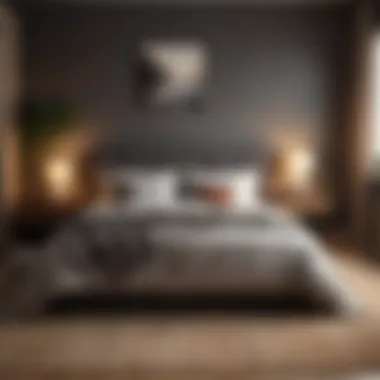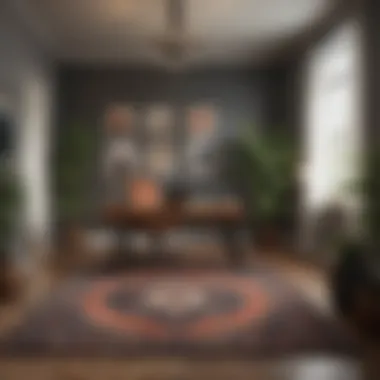Choosing the Right Rugs for Your Room Size


Intro
When it comes to creating a harmonious space, the rug you choose holds a more significant role than one might think. It’s not just about having something soft underfoot; it shapes the room's atmosphere, ties together various design elements, and even influences how spaces are perceived. With numerous sizes, styles, and fabrics available, picking the right rug can be akin to solving a multifaceted puzzle. This guide will illuminate the intricate relationship between room dimensions and rug selection, ensuring that you make the most informed decisions for your home.
Rugs can act as an anchor in a room. They define spaces, create comfort, and can even enhance the overall aesthetic of your environment. From living rooms bursting with personality to tranquil bedrooms, the right size and style of rug can change everything.
In this guide, we’ll cover essential aspects such as the impact of rug sizes on room design, ideal placement strategies, and what to consider based on your specific needs. Understanding these components will empower you to make choices that resonate with your style while serving practical purposes.
Prolusion to Room Size Rugs
Room size rugs aren't just decorative accents; they serve as foundational elements that shape the overall vibe of a space. Understanding their significance is crucial for anyone looking to enhance interior aesthetics. These rugs can create a comforting atmosphere, link various areas together, or even serve as a statement piece striking enough to draw the eye.
Navigating the world of rugs can be a bit tricky for those new to it. It's not just about choosing colors or patterns; the size plays an absolute key role in maintaining harmony within your room. When you look at rug sizes, there's more than meets the eye. They impact how a room feels, the way furniture interacts, and even the visual flow of the space.
Defining Room Size Rugs
Room size rugs generally refer to floor coverings that are large enough to anchor a room. They cover a significant amount of floor space, often extending under furniture. This can include areas such as living rooms, dining areas, or even bedrooms. The definition, however, is somewhat subjective and can vary based on the size of the room and its layout. For instance, in a smaller space, a rug measuring five by eight feet might be deemed a room size rug, while in a grand living room, one that is eight by ten feet could be more appropriate.
Choosing a rug for your room shouldn’t be taken lightly. To make that choice, understanding the dimensions, shapes, and how they align in your space is essential. Many people overlook how proper sizing can enhance not just aesthetics but usability as well.
Importance of Choosing the Right Size
Opting for the right rug size has several implications that reach beyond style. When a rug is correctly sized, it creates a pull—a sense of cohesion that helps define a space. A well-placed room size rug can distinguish areas, such as separating a seating area from a dining space or making sections of a larger room feel more intimate.
Moreover, an appropriately-sized rug can make a room feel larger or more spacious. Conversely, a rug that is too small may give a chopped-up look and undermine the unity of your decor.
Here are a few benefits of selecting the right rug size:
- Defines Space: Helps in visually separating different functions or areas within an open floor plan.
- Enhances Comfort: A larger area rug often enhances comfort, making it a cozy gathering point.
- Aesthetic Appeal: A properly sized rug can elevate the design of the room, adding style and sophistication.
By keeping these factors in mind, one can ensure that the selected rug becomes an integral part of the room rather than merely an addition. Room size rugs are not just about filling floor space; they are about creating an experience.
Measuring Your Space
Measuring your space is not just a preliminary step; it's the bedrock upon which your entire rug selection experience stands. A well-chosen rug can anchor a room, bringing harmony and function. Without accurate dimensions, you might end up with a rug that's either too small or too oversized, throwing off the entire aesthetic. Moreover, understanding your measurements sets the stage for creativity when designing your interior. A suitable rug can delineate areas for various activities—like lounging, dining, or working—enhancing not just looks but functionality as well. Investing the time upfront to get it right yields long-term benefits in style and usefulness.
Key Measurement Techniques
Getting those measurements spot on is crucial. Here are some effective techniques:
- Use a tape measure: This trusty tool is straightforward. Stretch it along the longest walls to establish length and width. Walk around and avoid furniture obstacles while you measure.
- Sketch it out: Sometimes, visualizing helps. Sketch your room layout on a piece of paper, jotting down dimensions as you go. This provides a clear overview when considering rug placement.
- Make use of digital tools: In this tech-savvy age, various apps can simplify the measuring process. Some allow you to input dimensions and provide images to help envision your design.
Utilizing any of these methods ensures that your measurements are precise, giving you a strong foundation for selecting the right rug.
Determining Room Dimensions
After you’ve gathered your measurements, understanding these room dimensions becomes vital. Each aspect plays a role in how a rug will work within your space. Consider:
- Total Area: Calculate the area by multiplying length by width. This number can guide you when considering various rug sizes, ensuring they fit within the overall layout.
- Ceiling Height: A room's height affects how spacious or cramped it feels. If you have high ceilings, a large rug may balance the space. For lower ceilings, smaller or flatter designs can help avoid overwhelming the area.
- Existing Furniture Layout: Take into account where your furniture sits. A good rule of thumb is to ensure at least the front legs of your seating options sit on the rug, establishing a cohesive look.
In sum, by understanding and applying your room dimensions properly, you can significantly enhance the overall feel and utility of your environment. Your efforts in measurements directly correlate to how inviting and organized your space ultimately becomes.
Understanding Design Principles
When it comes to interior design, every element in a room plays a crucial role in creating a cohesive and inviting atmosphere. Rugs, specifically room-sized ones, hold unique importance in this equation. Their placement and design can significantly influence the overall aesthetic appeal and functionality of a space. To harness the full potential of rugs, one must consider the foundational design principles that govern their use.
Color Theory and Room Interaction
Color theory isn’t just for painters; it’s a essential concept that influences how we feel in a given space. When selecting a rug, understanding its color palette is key. The hues of the rug can either complement or clash with the surrounding elements, affecting the mood of the room.
- Warm vs. Cool Colors: Warm colors such as reds and yellows inject energy into a room, making spaces feel more vibrant. On the other hand, cool colors like blues and greens promote tranquility, giving a calming effect. Choose a rug color that aligns with the desired atmosphere.
- Color Harmony: A monochromatic scheme includes various shades of one color, creating a unified look. In contrast, complementary colors are opposites on the color wheel and can create striking contrasts. Mixing and matching these principles will help achieve a balanced appearance.
- Natural Light Influence: The amount of natural light a room receives also affects color perception. A rug might look different in bright sunlight versus the shadows of evening. Testing your rug choice in various light conditions can help ensure it meets your expectations throughout the day.
For instance, a pale cream rug could brighten a dim room, while a deep navy can add depth and sophisticated richness.
"The right rug can serve as the heartbeat of a room, pulling together various decor elements and elevating the entire design."
Texture and Layering Effects
Texture is another critical aspect of design, especially when it comes to rugs. Different textures can evoke specific feelings and can be used to create layers, adding depth to a space. Here are some key considerations to keep in mind:
- Material Matters: The fabrics used in rugs—be it wool, synthetic fibers, or natural fibers like jute—bring their unique textures and feel. A plush, shaggy rug helps add coziness, while a flat-weave rug may contribute to a more modern, sleek ambiance.
- Design Layering: Combining rugs of varying textures can add complexity to the design. For example, layering a soft, thick wool rug over a flat jute rug can create a beautiful contrast that engages the senses.
- Functional Aspects: In high-traffic areas, a more durable and low-pile rug may be beneficial. However, in a bedroom or a reading nook, you might lean towards a plush rug. Think about where the rug will be placed and the kind of experience you want to create.


Textures can be tied to specific themes or styles. A vintage oriental rug can bring warmth and nostalgia, while a sleek, geometric patterned rug can reinforce a modernist approach.
By thoughtfully considering both color theory and texture interactions in your rug choices, you can enhance not only the aesthetic appeal of your room but also the overall functionality. This understanding lays the groundwork for creating spaces that not only look good but feel right.
Rug Sizes Explained
Understanding rug sizes is crucial in enhancing both the functionality and aesthetics of any room. The size of a rug can dictate how a space feels, while also impacting design coherence. Selecting the appropriate size allows homeowners to create distinct areas within a larger space, making it feel more inviting and organized. Additionally, the right rug size can help tie together various design elements and colors in a room, providing a sense of unity.
Common Rug Sizes and Their Uses
When it comes to rugs, size can vary greatly depending on personal taste and room dimensions. Standard rug sizes include sizes such as:
- 5x8 feet: This size works well in smaller spaces, like studio apartments or cozy living areas, where it can anchor furniture and define a seating area.
- 8x10 feet: A versatile option for medium-sized living rooms or dining areas, it accommodates several pieces of furniture on it which enhances a room’s layout.
- 9x12 feet: This size suits larger living rooms or dining rooms, providing ample coverage for furniture placement and foot traffic.
- Runner rugs: Measuring typically 2x6 feet or 3x10 feet, these are perfect for hallways, kitchens, or entryways, providing style while serving a practical purpose by protecting high-traffic floors.
Each of these sizes addresses specific room dynamics. For instance, placing a large 9x12 rug in a small room can overwhelm the space, while a smaller 5x8 in a large room may make it feel disjointed.
How Size Affects Room Perception
The size of the rug can significantly alter a room's perception, influencing how spacious or cozy it feels. A larger rug often makes a room feel more open, creating a luxurious vibe. On the other hand, smaller rugs can define specific areas, making spaces feel more intimate.
For instance, in an open concept living space, a well-placed 8x10 rug can visually separate the living area from the dining space, suggesting each area’s purpose without the need for walls. Conversely, using multiple smaller rugs can disjoint areas, allowing for varied designs but sometimes making space feel scattered.
Additionally, a rug can impact the height of the room. A low-pile rug can create a sleeker appearance, contributing to a sense of spaciousness. However, plush, high-pile options can add warmth and coziness, inviting lounging and relaxation.
"The right rug has the power to transform not just the floor, but the very atmosphere of a space."
Placement Strategies
Choosing the right rug isn't just about size or style; it's about placement. Rug placement can transform a room, creating visual interest, delineating spaces, and enhancing overall function. Understanding where and how to place your rug is critical to achieving a harmonious home. The right placement can define areas, guide foot traffic, and bring together disparate design elements to form a cohesive space.
Rug Placement in Living Rooms
When arranging your living room, the rug can serve as the room’s anchor. Ideally, the front legs of furniture should rest on the rug, creating a unified look. This grounding effect is vital in large spaces where furniture can feel disconnected. For instance, if you have a sofa facing a television, position a rug underneath the front legs of the sofa, along with the coffee table. This creates a cozy, intimate feel, drawing people into the seating area.
Consider the shape and dimensions of your living room when selecting your rug size. A rectangular rug works well in elongated spaces, while a round rug can soften angles in a more square-shaped room. Keeping at least a foot of floor visible around the edges of the rug can help maintain balance.
In smaller living rooms, opting for an area rug can visually expand the space. Choose a light, neutral color and a size that covers most of the area without overwhelming it. Keep in mind that a rug with a busy pattern can add depth and distract from cramped corners.
Guidance for Bedrooms and Dining Areas
In the bedroom, the rug can create a sense of warmth and comfort. Placing a rug at the foot of the bed allows for a soft landing when getting out of bed in the morning. Ideally, the rug should extend at least 18 inches beyond the sides of the bed, providing comfort and symmetry in the space.
In dining areas, the placement is equally strategic. The rug should be large enough to accommodate the chairs pulled out from the dining table. That means when seated or pushed back, all chair legs remain on the rug to avoid flooring damage and to maintain visual coherence. Generally, add 24-30 inches to the table dimensions to find an appropriate rug size.
Utilizing Rugs in Open Spaces
Open floor plans have become trendy, allowing for versatility but also presenting challenges in defining distinct areas. Rugs can play a pivotal role in zoning within such spaces. For instance, in an open-concept area where the kitchen transitions into the living area, a sizable area rug can visually separate the two, marking boundaries without erecting walls.
Consider placing rugs in seating areas around coffee tables or in front of entertainment units. This not only grounds the space but also invites social interaction. The key is to ensure that the rugs are large enough to include all relevant furniture pieces, creating an agreeable flow.
Enhancing Ambiance and Functionality
In the world of interior design, the rugs we choose have more than just a decorative role; they can significantly enhance both ambiance and functionality of our spaces. This section dives into how the right rug can transform a room from merely functional to stunningly inviting. Homeowners and design enthusiasts alike should consider not only the visual appeal of their rugs but also how these textiles can create comfort and purpose.
The placement and size of a rug can influence how a space feels and operates. For instance, in open-concept layouts, rugs can be instrumental in defining areas, helping to create a sense of separation for different purposes like lounging or dining. This zoning effect can make an expansive home feel more cozy and connected.
Furthermore, the material and color of rugs can alter perceptions of space. Light, airy colors can create a sense of openness, whereas darker shades can give a feeling of warmth and intimacy. Likewise, the texture of a rug may influence how welcoming a space feels. Soft, plush rugs invite people to linger, whereas more durable materials speak to functionality, especially in high-traffic areas.
"Rugs are the unsung heroes of interior spaces, blending style and purpose in one seamless package."
Creating Zones with Rugs
One of the most significant advantages of room size rugs is their ability to create distinct zones within a single space. For example, in a sprawling living area, a large, plush rug can anchor a seating area, clearly delineating it from the rest of the room. This not only helps in organizing the layout, but also enhances the overall flow of the space.
When selecting a rug for zoning, consider the following:
- Size Matters: Ensure the rug is large enough to encompass all key furniture pieces within the designated area. Ideally, at least the front legs of sofas and chairs should sit on the rug for a cohesive look.
- Color and Patterns: Choose colors or patterns that resonate with the zone’s purpose. For a lively reading nook, brighter colors might work, while a muted palette can instill relaxation in a bedroom.
- Shape and Style: The shape of the rug can complement the furniture arrangement. Round rugs work well in areas with circular furniture layouts, while rectangular ones fit traditional setups.
Additionally, using multiple rugs in a larger space can be a savvy strategy. Different rugs can define dining spaces, play areas, and lounge spots, facilitating movement and interaction within an open layout.
Balancing Style and Practicality


When it comes to choosing rugs, finding the sweet spot between aesthetics and function can be a real balancing act. On one hand, you want a rug that ties your design elements together. On the other, functionality often dictates that your rug can stand up to everyday life—spills, traffic, and pets, for instance.
To strike this balance, consider these aspects:
- Material Selection: For high-traffic areas, look towards durable materials like polypropylene or wool blends which can survive the wear and tear of daily use. Cotton rugs tend to be easier to clean but may not hold up as well under heavy foot traffic.
- Design Versatility: Opt for styles that can easily blend with other decor elements. A neutral-colored rug with subtle patterns can harmonize with changing decor themes over time.
- Caring for Your Rug: Think about maintenance needs as well. Some rugs require regular cleaning, while others can simply be vacuumed. Knowing you can keep your choice clean without a hassle adds to its practicality.
Balancing style and practicality allows for a beautiful home that can withstand the rigors of life while still looking like it stepped out of a magazine.
Choosing the Right Material
Selecting the right material for a room size rug is not just a minor detail; it's a critical component that can transform your space. Different materials come with their own set of characteristics that influence not only the aesthetics but also the functionality of the rug. When homeowners, interior design enthusiasts, or anyone looking to spruce up their living environment considers a rug, they should prioritize material as a driving factor.
The right material can define the comfort of your space, impact longevity, and dictate how much maintenance you’ll need. Choosing wisely can help strike that delicate balance between style and practicality.
Durability and Care Considerations
Durability is paramount when it comes to rugs, especially in high-traffic areas of the home. Some materials can handle the rough and tumble of daily life, while others may show wear and tear quicker than expected. For instance, wool rugs, known for their resilience, can withstand heavy foot traffic and are quite forgiving when it comes to spills.
Key points to consider about durability and care for different materials:
- Wool: Naturally stain-resistant and durable, requires periodic vacuuming and occasional professional cleaning.
- Nylon: A budget-friendly option, extremely durable, easily cleaned but might feel less luxurious to the touch.
- Cotton: Soft and affordable, but can show wear quickly in busy areas; best for low-traffic rooms.
- Vintage or antique rugs: Often made from various materials, may need more specialized care given their age and richness in texture.
Caring for the rug also goes hand in hand with its material. Some require specific cleaning methods or regular maintenance to keep them looking fresh. It’s wise to know before you buy to avoid unexpected hassles later.
Material Options for Different Needs
When it comes to selecting a rug, it’s essential to match its material with your specific needs and lifestyle.
- For Young Families: Polyester or nylon may be ideal. They are durable, resist staining, and are easy to clean, which is vital when kids and pets are involved.
- For Luxury Seekers: Silk or high-quality wool offers an elegant touch. However, silk may not be practical in high-traffic areas due to its delicate nature.
- For Allergy-Prone Individuals: Consider natural fiber rugs like jute or sisal, as they are less likely to trap dust and allergens but may need more frequent cleaning compared to synthetic options.
- For Outdoor Spaces: Acrylic or polypropylene are fantastic choices, being resistant to fading and mildew, making them excellent for patios or gardens.
Ultimately, the material you choose should align with how you live, the aesthetics you prefer, and the environment in which the rug will reside.
Incorporating Rugs into Various Styles
In the world of home design, rugs are much more than mere floor coverings; they serve as vital accessories that can either unite or contrast with the surrounding decor. Effectively incorporating rugs into various styles is crucial for establishing the desired ambiance of a room. The right rug can add warmth, texture, and a splash of color to an otherwise bland design scheme. Whether you're looking to maintain a certain aesthetic or shake things up, rugs can play a transformative role.
Traditional vs. Contemporary Looks
When one thinks of traditional decor, images of rich textures and classic patterns often come to mind. These styles frequently emphasize intricate designs, often featuring floral or geometric motifs that have stood the test of time. An appropriate rug for a traditional setting might be a Persian or Oriental design, which complements the formal elegance of the overall scheme. The deep color palettes and luxurious materials in these rugs can effectively anchor the space and add depth.
In contrast, contemporary interiors lean toward simplicity and minimalism, often marked by clean lines and muted tones. Here, rugs are typically chosen for their ability to serve as subtle statement pieces that add interest without overpowering the design. A sleek, geometric-patterned rug in a neutral color can enhance a modern space, maintaining its airy feel while offering a hint of texture and visual intrigue.
While styles might differ, the choice of rug should always aim to create a sense of balance. For instance, a plush shag rug can bring warmth to a sleek, modern room, creating a cozy nook without clashing with the overall design.
Cohesion with Eclectic Decor
Eclectic decor can be a delightful challenge. It invites the combination of various styles, colors, and textures, but this can lead to a visually chaotic environment if not handled with care. A well-chosen rug can become the thread that weaves all these disparate elements together.
To achieve cohesion in an eclectic space, look for rugs that share common colors or patterns with other design elements. For example, if your decor features a mix of bright colors and bold patterns, consider a more subdued rug with hints of thosesame colors. This approach not only ties the room together but also gives it a polished touch.
Another strategy is to choose a rug that brings something entirely different to the table—this can sometimes offer a fresh perspective. A vintage kilim, with its weathered charm, can complement sleek furniture and contemporary art pieces.
In this playful balance, rugs serve as creative canvases; they allow the homeowners to express their personalities through their spaces. With thoughtful selection, rugs can reinforce the curated look of an eclectic room, offering both aesthetic unity and practical comfort.
"Incorporating a rug is about enhancing your space, making it feel more inviting—without compromising on style."
Ultimately, the integration of rugs into various styles requires a careful consideration of color, texture, and overall coherence. Achieving the right balance can elevate a room from ordinary to extraordinary, setting the stage for warm gatherings or quiet evenings at home.
Maintenance and Care for Rugs
The longevity and aesthetic appeal of rugs are greatly influenced by how well they are looked after. Proper maintenance and care for rugs can prevent costly replacements and keep your floors looking fresh and inviting. Rugs can act as visual anchors in a room, so ensuring they remain in good condition is vital for any homeowner or design enthusiast. When understanding the ins and outs of rug care, one should consider aspects like cleaning techniques suitable for different materials, as well as strategies to prevent general wear and tear.
Cleaning Techniques for Different Fabrics
Cleaning methods can vary significantly depending on the material of the rug. Knowing the right technique is essential to avoid damage that could pile up over time. Here are some common rug materials and the best cleaning practices:
- Wool Rugs: These are known for their durability, but they can attract dust and dirt. A simple vacuum once a week can maintain their look. For deeper cleaning, consider using mild soap and water. Always test in a hidden area first to ensure colorfastness.
- Cotton Rugs: Easier to clean, cotton rugs can often go into the washing machine. Opt for cold water and gentle cycles. If they are not machine washable, a mixture of water and vinegar can be effective.
- Synthetic Rugs: These are generally stain-resistant and can be cleaned with mild detergents and a scrub brush. They tolerate a good scrubbing without losing their shape.
- Silk Rugs: Silk requires special attention. It’s best to hire professionals for cleaning silk rugs to avoid any degradation of the fibers.
"When it comes to rugs, an ounce of prevention is worth a pound of cure. Regular upkeep can save you a ton of trouble down the road."
Preventing Wear and Tear


A little foresight can go a long way in preserving the life of your rugs. In high-traffic areas, rugs can quickly show signs of wear. To prevent this:
- Use Rug Pads: These protect your floors and the bottom of your rug. They provide cushioning, which can minimize slipping and wear.
- Rotate Regularly: Allow for even wear by rotating your rugs every few months. This helps avoid fading from sunlight on one side.
- Limit Sun Exposure: Prolonged sunlight can fade colors. Use curtains or shades to limit direct sunlight.
- Avoid High Heels: If possible, ask guests to remove their shoes when entering your home. High heels can puncture and damage the fibers.
- Promptly Address Spills: Should an accident occur, cleaning it immediately can prevent lasting damage. Blot the stain rather than rubbing it, and follow specific cleaning instructions for the material.
Understanding and implementing these care tips will not only improve the appearance of your rugs but will also enhance the overall ambiance of your living spaces.
Sourcing Quality Rugs
Finding the right rug is more than just picking the one that looks pretty. It’s all about sourcing quality rugs that suit your space, style, and practical needs. To do this effectively, one must consider where to purchase these rugs and the reputation of the retailer.
Quality sourcing ensures that the rug not only looks great, but also wears well over time. It involves a few essential factors, such as the material, craftsmanship, and the retailer's reliability. Investing in a quality rug can transform a room, offering both aesthetic appeal and functional benefits.
Evaluating Rug Retailers
When looking to purchase a rug, a key part is evaluating rug retailers. This process should be more than just a quick browse; it demands some research. Here are several steps to consider:
- Reputation: Check online reviews and testimonials. Retailers with a good track record might stand the test of time better than others.
- Selection: A diverse range of options indicates a reliable retailer. The more choices available, the better chance to find a quality rug that meets specific needs.
- Customer Service: Seek retailers known for their helpful customer service. Being able to ask questions and receive thorough answers is invaluable, especially when an investment is on the line.
- Return Policies: Quality retailers stand by their products, often offering generous return policies. This shows confidence in their merchandise.
"A rug can anchor your space, but it should also be a smart investment. Choose wisely."
Online vs In-Store Shopping Debates
The debate over online versus in-store shopping for rugs is one that many face today. Each option offers its batch of pros and cons:
Online Shopping:
- Convenience: Shopping from home can be far more relaxed. You can sift through a larger selection and compare prices at leisure.
- Variety: Online stores often have a wider range of styles, colors, and sizes than physical stores.
- No Pressure: Shopping online means no pushy salespeople trying to make a sale. You can take your time.
In-Store Shopping:
- Tactile Experience: You can feel the material firsthand. This is instrumental for understanding both texture and build quality.
- Visual Appeal: Seeing the rug in person allows you to better gauge how it might look in your space.
- Instant Gratification: No waiting for shipping; you can bring the rug home right away.
Both options hold weight in this decision-making process. Many find a hybrid approach works well—research rugs online but view them in-store to make the final decision. Each method has a valid place in the quest for the perfect room size rug.
Rug Trends and Innovations
Rug trends and innovations form an essential part of selecting the right rug for your home, especially as it relates to the evolving aesthetic preferences and functional needs of contemporary living spaces. These trends offer a glimpse into the intersection of style, technology, and sustainability, enabling homeowners to make informed choices that go beyond mere aesthetics. The right rug can tie a room together, but keeping an eye on what’s current can show a commitment to modernity and taste.
Emerging Styles in Rug Design
When considering new styles, one can't help but notice that geometric patterns are making waves in the rug world. They add a contemporary edge to traditional designs, turning up the volume on plain decor. Lines, angles, and contrasting colors work together to create a visual feast that excites the eyes and provokes conversation. For instance, a bold black and white geometric rug could serve as a statement piece in an otherwise understated room.
Moreover, handmade rugs are gaining traction. With artisan craftsmanship at the forefront, handmade pieces offer uniqueness that mass-produced options simply cannot match. These rugs often come from regions known for their intricate weaving techniques, such as Persia or India. Choosing one of these rugs means investing in a piece of art that reflects not only the home’s personality but also cultural heritage.
In addition, the rise of minimalism in design showcases the beauty of simplicity in rug selections. Soft, muted tones and clean lines are common in minimalist aesthetics. A light beige or grey area rug can create a sense of calm in a busy space, serving as a perfect base for vibrant furniture or accessories.
"Emerging styles challenge our notions of traditional decor, pushing the boundaries of creativity and sustainability in ways that resonate well beyond mere furnishings.”
Sustainability in Rug Production
Sustainability is paramount in today’s design choices, and the rug industry is no exception. More consumers are prioritizing eco-friendly options as they consider their home decor. This growing awareness leads manufacturers towards producing rugs made from natural fibers like jute, wool, or organic cotton. These materials not only reduce the carbon footprint but also contribute to a healthier indoor environment.
Additionally, various brands are now embracing recycled materials. Rugs composed of repurposed plastics or upcycled textiles are popping up on the market, providing a chic aesthetic while aiding the fight against waste. The production processes for these rugs require fewer resources compared to traditional methods, showcasing an innovative approach to rug manufacturing.
For homeowners keen on making conscious choices, seeking out certifications like GLOBAL ORGANIC TEXTILE STANDARD (GOTS) can guide them to reputable product options. These certifications are indicators that the rug meets stringent environmental criteria during its production phase, ensuring that it is not only beautiful but also ethically produced.
In summary, keeping an eye on rug trends and innovations not only enhances your home’s aesthetic but also opens up opportunities to align your decor choices with personal values regarding craftsmanship and sustainability. As the industry continues to evolve, those looking to furnish their spaces would do well to factor in these trends as they embody both modern design sensibilities and responsible living.
The End
In wrapping up our exploration of the pivotal role that room size rugs play in home decor, it's key to appreciate how such simple pieces can shift the dynamics of a space. Selecting the right rug goes beyond aesthetics—it's about harmonizing functionality, comfort, and style into your living environment. They create a sense of warmth and coziness, often influencing the mood of a room on an emotional level.
A carefully chosen rug can act as the foundation for a room, tying together disparate design elements and providing a visual anchor around which everything else revolves. In essence, the right rug doesn’t just fill space; it defines it. This can be particularly important in areas where people gather, as it can delineate spaces, promote socialization, and enhance the overall functionality of the area.
Recap of Key Points
- Understanding Size Matters: Rugs come in various sizes, and matching a rug to the dimensions of a room is crucial for visual balance and spatial efficiency.
- Placement is Key: Where you place a rug can make or break its impact. Knowing the best strategies for living rooms, bedrooms, and open spaces is vital.
- Materials Matter: The choice of material affects durability and care, impacting the overall aesthetic and practicality of a rug.
- Design Synergy: A rug should complement the overall design theme of the room while still providing a personal touch that reflects your taste.
- Care and Maintenance: Proper cleaning and care extend the life of your rug, ensuring it continues to serve not just a decorative purpose, but also a functional one.
Final Thoughts on Rug Selection
As you venture into choosing the perfect rug, keep in mind that this decision plays a substantial role in defining your interior space. Rugs can transform a stark room into a cozy enclave, they can accentuate style while serving practical purposes like safety or comfort underfoot.
When you approach rug selection thoughtfully, considering dimensions, patterns, and placements, you recognize their potential as transformative pieces in a home. Don't hesitate to explore various styles and consider how each complements your unique space—it’s an investment that can yield significant returns in comfort, elegance, and harmony.
- Embrace the art of selecting a rug; it’s about precision and personality.
- Remember, the right rug can turn a house into a home, ensuring each step taken in that space feels inviting and grounded.
A rug is often the unsung hero of interior design, silently holding together the threads of a room's identity.







